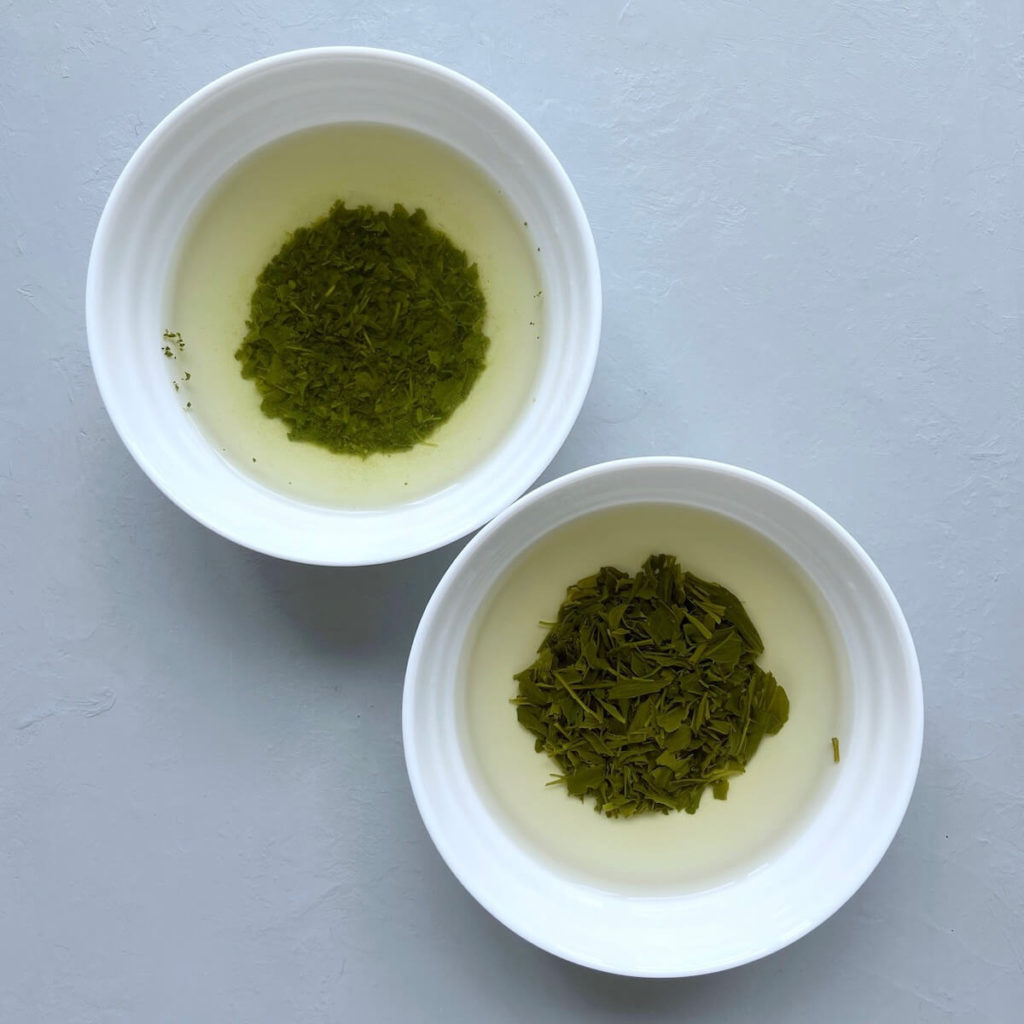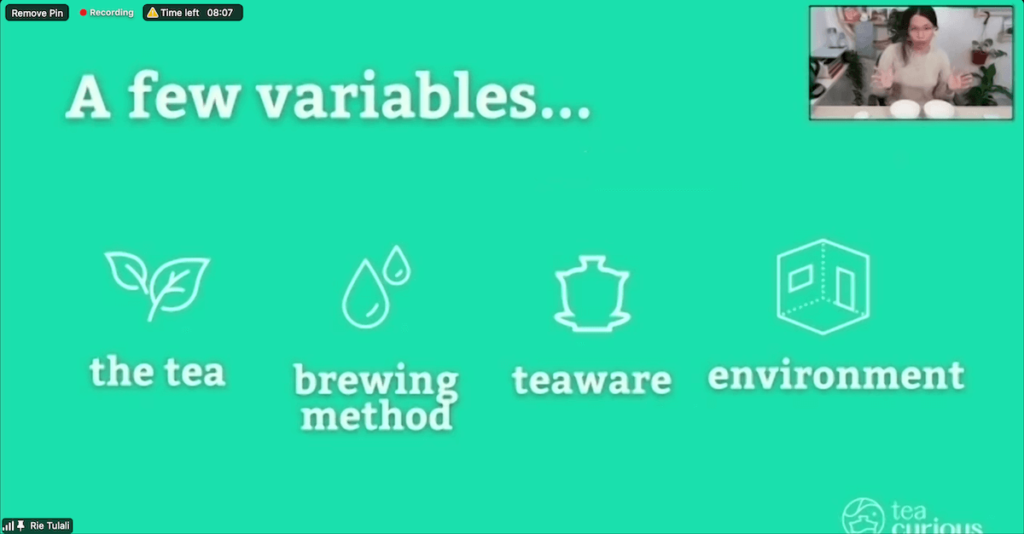
Tea evaluation is not something I have a lot of experience with. So, when I saw Rei from Tea Curious running a workshop on how to do it at home, I was intrigued.
Description: “In this workshop, you’ll learn how to effectively evaluate teas from anywhere in the world, using a simple setup you can easily make at home.”
When I review teas I tend to use the parameters set out by the tea company. This can include how to brew the tea, the amount of tea, water temperature, and time. This allows me to evaluate the tea using the company’s benchmark of what they believe is the best version of the tea. This also means anyone buying the tea, will hopefully have a similar experience.
I tend to forgo evaluating the actual quality of a tea since I don’t feel overly qualified to do so. However, the quality of a tea can indicate a lot about how it will taste. So, I thought this workshop would be useful and provide information on indicators to look for!
Live Workshop Session
Rie’s workshop was a part of the Nomad Tea Festival, which was a hybrid in-person and online tea event held between August 5th to 8th, 2022. The event was in its 4th year and was held in Melbourne, Australia, so I attended virtually from Canada. I decided to attend this workshop because I have met Rei before in the past and also attended some of her workshops and her course on water.
Prior to the workshop, the website listed that participants should bring two teas to compare, two identical bowls (soup or rice bowls if possible), and soup spoons. I picked a Japanese Sencha from Shizokua and a Tamaryokucha from Nagasaki and used 2 white soup bowls, and 2 white disposable spoons since I didn’t have any other white spoons. I prefer using white tea tools as it allows me to see the colour of the liquor.

In the workshop, Rei mentioned that this is one of the methods used by Taiwanese tea producers to evaluate tea. The breakdown of the method is to use the same ratio of water to tea and pouring boiling water directly onto the tea. The tea is allowed to continually brew to see what is brought out. This is a useful method that mitigates various variables when it comes to brewing tea, including the tea itself, the brewing method, the teaware used, and the even environment.
The workshop was structured in a way where Rei walked you step-by-step through the method, which I appreciated. She provided explanations and tips throughout the whole workshop. A few elements Rei suggested we look out for when conducting an evaluation are unpleasant bitterness, clarity of the liquor, as well as flavour and aftertaste. Rei also encouraged us to intermittently taste the brew and also examine and play with the wet leaves. I generally just give the wet leaves a cursory look and smell, so it was nice to play with the leaves and really look at them.

When it came to brewing the sencha and Tamaryokucha, my initial theory was the tamaryokucha would be a cloudy neon colour and have a bitter taste since the dry leaves were more broken. While I was right on the clarity and colour of the liquor, it was actually the sencha that was bitter which surprised me! The sencha had a darker liquor that was bitter right off the bat whereas the tamaryokucha only had some faint astringency at the back of the sip. Overall, this was a pretty eye-opening experience as I would have never normally tasted the teas under these parameters because Japanese teas generally aren’t steeped at this temperature.
Live Q&A and Pratice Session

Since the workshop was only a 45-minute session, Rei provided an additional Q&A and practice session a week later which I also attended. It was a group of four people, so it was a casual relaxing environment. I compared two milk oolongs from different tea companies because I wanted to see if they were the same tea as they had the same price point. Spoiler: they weren’t! I was able to re-try the brewing method which was fun. Rei noted that this is a good method if you have a goal in mind or a question with some time to focus on the tea. This was true in my case as my two sessions answered completely different questions!
Workshop Final Thoughts
I enjoyed the workshop (and Q&A + practice session) with Rei. As a presenter, she was friendly, engaging, and knowledgeable. I have met Rei in the past and she is exactly the same in person! I would recommend doing the live session (or in person if possible) since having Rei do a walkthrough really helped illuminate how the method works. However, keep in mind that this is just one of many evaluation methods for tea. For example, Rie likes this method because you don’t decant the tea after but others may not like it for that very reason. While I had heard of this method before, I had not tried it for myself. However, I feel this workshop gave me the confidence to try this method on my own in the future if I want to compare teas or have a more in-depth examination of a tea (4/5 rating)!
- Company: Tea Curious
Nomad Tea Festival
The Nomad Tea Festival itself wasn’t without its hiccups and I thought it was important to address it, but not take away from Rei’s workshop. The bulk of my issues with the festival came down to the website, the sign-up process, and the delivery mechanism of the workshops. This is my first time attending the event, so I knew very little about it. When I first visited the website, I found it hard to navigate (ie. overload of images, broken links, and confusion about the prices), so I opted to sign up for two workshops through Eventbrite (which had missing information about how some of the workshops were pre-recorded). After registering, I wasn’t provided links to the two workshops, which is normally done automatically through email. I was only sent a confirmation email.
I found out afterwards that there was a technical issue and no event links were sent out to any of the virtual attendees. The Nomad Festival Instagram later provided me with the Zoom host link through Direct Message since I had contacted them prior asking how to access the workshops. The festival also posted the link on Instagram but I didn’t see it mentioned on any other social media. Since the workshops were advertised as a hybrid in-person and online event, the bare minimum the Nomad Tea Festival should have done is send out an email blast to all the attendees with the Zoom link. Therefore, with all the issues I encountered this year, I am personally on the fence if I will attend next year.
- Company: Nomad Tea Festival
The question of the post: How do you evaluate teas?
Liked this event recap of Tea Curious’ Setting up the Tea Lab? Pin it!


2 comments
Heck yeah Connie! I think you have a really good grasp on this method haha.
Thanks for the review and insights, and for doing the side-by-sides with us in a really attentive way. It’s always a treat to practice with you. I learn a lot just answering your questions and hearing your observations. 🙂 and I never even thought to use this method to see if two teas are the same, LOL, just an excellent use of the method.
Let me know if you ever use it again, or maybe we could evaluate the same tea together sometime. That’d be fun.
Yes, please! Tell me when you are free! It was fun and informative.